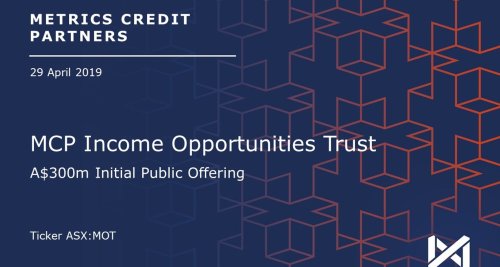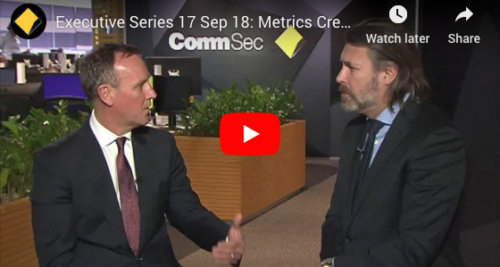How private loan transactions are negotiated to deliver investment returns
Investors may not realise that under the hood of a private debt fund are many individually negotiated loans that ensure unitholders receive a certain monthly income and protections to mitigate against capital losses.
For Andrew Lockhart, Partner at Metrics Credit Partners, each loan is a prudently negotiated deal designed to strike a balance between providing businesses with the capital they need to succeed while ensuring investors achieve an acceptable return on the risk undertaken.
Each opportunity begins with assessing a company’s cash flow, discussions with management, and gaining a rigorous understanding of the business model and its capital structure. And for certain transactions, there is also the possibility of participating in upside beyond just interest payments.
“You might as a lender say, ‘we’ll provide the debt to you’ but we may do that on the basis that we also participate in the upside and capital gains. So, we might negotiate to take equity in the company, or we might take options or warrants over the equity or we might enter into a profit-share arrangement.”
In this interview, Lockhart expands on his process for assessing investment opportunities, where private debt sits in the capital structure, and how investors can achieve capital growth in this asset class.
Edited transcript
What’s your process for assessing investment opportunities?
I think the main thing that you’re looking for as a lender is, what is the alternative means that a company can gain access to financing? And then you’re looking to understand the stability and certainty associated with the capacity to generate cash flows, service and repay the debt. So at the end of it, you’re not looking for companies that are going to have massive upside in terms of equity value, if they’ve got uncertain or volatile cash flows. So certain consistent cash flows that are not volatile, business models that are well-diversified, management teams that are credible and a capital structure, means that you’re not then also exposed to volatility around the asset price.
So from a lender’s perspective, the two things you always look at is the capacity to generate cash flows, to service and repay your debt. And then the second thing you’re looking at is what’s the confidence that I’ve got that under distress or stress conditions, we as a lender can still get our money back. Equity might lose money but we as a lender have got our money back. So the two things, debt service and exit scenarios are very important to monitor in terms of making an acceptable loan transaction
Where does private debt sit in the capital structure?
Equities are where you sit in the capital structure. So as a lender, you’re lending at the lowest risk part of the capital structure. So if you think about a capital structure, you’ll have senior debt, subordinated or mezzanine debt, and then the equity. Equity is the position that represents the risk of first loss to the company. So if you get a period where you’ve got volatility in valuations, now that volatility should be worn by equity. So if you think about it in the context of a property, if it is worth $100,000,000 and you’ve lent $50,000,000 the value of the property can fall by $50 million before you, as a lender, have been exposed to the risk of capital loss. That loss of the first $50 million is absorbed by equity. And so from a lender’s perspective or from a debt versus equity perspective, you’ve got protections that are afforded to you.
It’s a contractual obligation. So when you enter into a loan, the company is contractually obligated to pay, service and repay the debt. And so for you, as a lender, you have terms and conditions that can determine how that company performs. And you’ve got rights and the ability to control aspects of the business’s operations to ensure that your interests are protected. So for example, as a lender, you can determine whether or not the company can pay a dividend to shareholders. If the company’s not generating sufficient cash, you as a lender might restrict a dividend.
You can restrict the company’s ability to make acquisitions or the company’s ability to dispose of assets and not use those proceeds to repay debt. If a company sells an asset, generally, it’s for the source of repayment of debt and as a lender, you can control that through appropriate terms, conditions, covenants that control those aspects. And then obviously you’re in a secured position. So as a lender, you’ve got the highest-ranking position in terms of the risk of the company. The greatest level of risk is actually born by equity and shareholders.
Can private debt provide investors with capital growth?
When we lend, one of the skills that you have as a lender is that private debt is very much not a traded market, you’re not buying and selling debt over an exchange. And so when I sit down to negotiate a transaction with a company, we’re seeking to understand what is the capacity of the company to generate cash flows, service and repay the debt, what’s the risk associated with the transaction, how can we structure the terms and conditions to assist the company to grow. Provided that we’re comfortable with the risk is acceptable, then it’s a negotiation about what’s the appropriate pricing for that risk. And so as a lender, what you’re seeking to do is to ensure that our investors are properly rewarded for the risk that we take.
So when you structure and negotiate a transaction with a company, you’re setting the terms, conditions and pricing but equally, if you believe that the capital that we’re providing to that company is scarce, it’s valuable, it’s unique. They may not have access to a lot of debt capacity. So you might as a lender say, “Okay, well, we’ll provide the debt to you but we’re going to do that on the basis that we also participate in some upside capital gains. So we might negotiate to take equity in the company or we might take options or warrants over the equity. We might enter into a profit share.”
So there is a whole range of ways in which you can do that. So that investors in our funds might be rewarded for the debt that’s provided. So interest and fees that are provided on the loan, but equally if the company is successful and it performs, then you might actually also provide investors with participation in upside capital gains through those instruments of equities or warrants or options.
Do your funds frequently come across such opportunities?
We’ve been a lender and taken equity interest in a number of companies that we lend to. And that’s a feature of certain strategies we operate. Not all of our funds are permitted or mandated to do that. The core of our business is to lend money but equally, we see more and more opportunities where our clients are coming to us, asking us to participate in the growth of their business. And often the growth capital that’s required isn’t necessarily debt financing. It’s at a point in the capital structure where it’s really an equity-type risk. And so we might provide the debt, but if we’re providing debt that is perhaps high yielding or providing that access to growth opportunities for the shareholders, then we want to capture that. And so we have done that on a number of occasions and we actually have, through one of our funds, a dedicated strategy focused on providing investors with not only a return from the debt part of the capital structure but also participation in inequity upside.
19 July 2021 – How private loan transactions are negotiated to deliver investment returns
Other News
Podcast: The Rules of Investing | From Cold Call to Capital Giant
In this episode of The Rules of Investing, Metrics Group CEO & Managing Partner, Andrew Lockhart discusses the conditions that…
Metrics Credit Partners Completes Acquisition of Taurus and BC Invest
Metrics Credit Partners (“Metrics”), a leading Australian based alternative asset management firm, has today successfully completed the acquisition of Taurus…
INSIGHTS
MCP Income Opportunities Trust (MOT) lists on ASX
Sydney, 29 April 2019: The Trust Company (RE Services) Limited (ABN 45 003 278 831) (Responsible Entity) is the responsible…
MCP Master Income Trust wins Lonsec Listed Fund Award
The award came a year after MXT was listed on the Australian Securities Exchange






